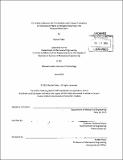| dc.contributor.author | Foley, Rachel (Rachel L.) | en_US |
| dc.contributor.other | Massachusetts Institute of Technology. Department of Mechanical Engineering. | en_US |
| dc.coverage.spatial | n-uss-- | en_US |
| dc.date.accessioned | 2014-01-09T19:47:41Z | |
| dc.date.available | 2014-01-09T19:47:41Z | |
| dc.date.issued | 2013 | en_US |
| dc.identifier.uri | http://hdl.handle.net/1721.1/83714 | |
| dc.description | Thesis (S.B.)--Massachusetts Institute of Technology, Department of Mechanical Engineering, 2013. | en_US |
| dc.description | Cataloged from PDF version of thesis. | en_US |
| dc.description | Includes bibliographical references (pages 23). | en_US |
| dc.description.abstract | Currently, hydropower plants serve as one source of green energy for power companies. These plants are located in various geographical regions throughout the United States and can be split into three main classifications: run of river, basins, and reservoirs. The energy production at hydropower plants can vary on a monthly basis, and this change is recorded for company purposes. This study used data provided for five reservoir plants in the Missouri River Basin to model these variations, and determine a correlation between the precipitation and energy production. The parameters provided and modeled included the precipitation measured at each hydropower plant, the evaporation from the surface of the reservoir, the inflow into the reservoir, the outflow from each plant, the energy generation of each plant, and the reservoir elevation every month from June 1967 to December 2012. Using these monthly values, two separate models were created: a model that relates the power generation as determined from the energy production to the outflow and the effective hydraulic head at the hydropower plants, and a second model correlating the effective hydraulic head and the precipitation measured in the reservoir. The results showed that the energy production varied proportionally to the product of the monthly precipitation and outflow for each of the hydropower plants, up to the maximum installed capacity at each of the plants. Beyond this maximum installed power, there was no correlation between increased precipitation or outflow and the power produced. | en_US |
| dc.description.statementofresponsibility | by Rachel Foley. | en_US |
| dc.format.extent | 29 pages | en_US |
| dc.language.iso | eng | en_US |
| dc.publisher | Massachusetts Institute of Technology | en_US |
| dc.rights | M.I.T. theses are protected by
copyright. They may be viewed from this source for any purpose, but
reproduction or distribution in any format is prohibited without written
permission. See provided URL for inquiries about permission. | en_US |
| dc.rights.uri | http://dspace.mit.edu/handle/1721.1/7582 | en_US |
| dc.subject | Mechanical Engineering. | en_US |
| dc.title | Correlation between the precipitation and energy production at hydropower plants to mitigate flooding in the Missouri River Basin | en_US |
| dc.type | Thesis | en_US |
| dc.description.degree | S.B. | en_US |
| dc.contributor.department | Massachusetts Institute of Technology. Department of Mechanical Engineering | |
| dc.identifier.oclc | 864437417 | en_US |
